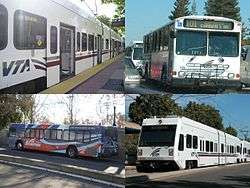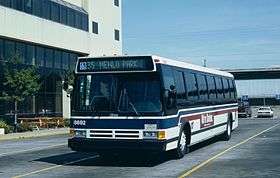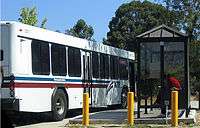Santa Clara Valley Transportation Authority
 | |
 | |
| Overview | |
|---|---|
| Locale | San Jose, California |
| Transit type | Bus and light rail |
| Number of lines | 82 bus, 3 light rail |
| Number of stations | 62 |
| Daily ridership | 142,100 (Q3 2013)[1] |
| Website | http://www.vta.org |
| Operation | |
| Began operation | 1973 |
| Operator(s) | Santa Clara Valley Transportation Authority |
| Technical | |
| System length | 42.2 mi (67.9 km) (light rail) |
The Santa Clara Valley Transportation Authority (VTA) is a special-purpose district responsible for public transit services, congestion management, specific highway improvement projects, and countywide transportation planning for Santa Clara County, California. It is one of the governing parties for the Caltrain commuter rail line that serves the county.
History
Founding of Santa Clara County Transit District
In 1969, Santa Clara County had three private bus companies, all of which were in serious financial trouble: Peninsula Transit, San Jose City Lines, and Peerless Stages.[2] The California Legislature passed a Santa Clara County Transit District Act in 1969.[2] However, the Act did not supply any funding for the new district. The formation of the Santa Clara County Transit District was rejected in 1969 and 1970 before it was finally approved by county voters on June 6, 1972.[2] The SCCTD took over the operations of the three old bus companies on January 1, 1973.[2]
On September 26, 1974, the county Board of Supervisors dissolved the Public Works Department.[3] Non-transit operations went into a new General Services Agency, while transit operations were placed into a new Santa Clara County Transportation Agency.[3]
In its early years the Santa Clara County Transportation District approached the task of replacing the bus fleet it inherited from its predecessors, which was in need of upgrades and repair. At first the district bought propane-fueled Twin Coaches[4] and Gilligs.[5] SCCTD switched to an all-diesel fleet after six buses went up in flames between December 1977 and April 1978.[6] At the time, critics referred to the buses as "rolling propane bombs."[6]

On March 6, 1976, Santa Clara County voters approved a half-cent sales tax, Measure A, to help support the Santa Clara County Transit District. In 1977, the primary Overhaul and Repair Facility was built at the Cerone Yard. Also in 1977, County Supervisors decided to change the bus fleet from propane to diesel and ordered 102 buses. By 1979, three additional bus yards were built and commissioned into service.[7]
Another issue was improving the diversity of its workforce. In December 1978, the SCCTD approved an affirmative action plan for the Transportation Agency. After a long legal battle, the U.S. Supreme Court by a 6-3 majority upheld the gender component of the plan against a civil rights challenge on March 25, 1987.[8]
Formation of VTA
On January 1, 1995, the SCCTA merged with the county Congestion Management Agency to become the SCVTA. For convenience, the acronym was later shortened to VTA.
In 1996, voters approved a half-cent general county sales tax, Measure B, and a companion list of transportation projects recommended to be funded with Measure B, called (1996) Measure A. The two measures were designed to adhere to the rule in the California State Constitution that requires a two-thirds supermajority to pass any special purpose sales tax, but only a majority vote to pass a general sales tax. The measure was challenged, but in 1998, the California Supreme Court ruled that the two measure system was valid.[9] The tax was to be collected for ten years.
2000 Measure A sales tax and VTA's BART Silicon Valley Extension
In 2000, voters approved a 30-year extension of the 1996 sales tax to fund an extension of Bay Area Rapid Transit to Santa Clara. 2000 Measure A also includes funding for light rail extensions, bus service expansion, expansion and electrification of Caltrain service,[10] and connections from San Jose International Airport to BART, Caltrain and VTA light rail. The measure was placed on the ballot by the VTA and does not include funding specifically for highway projects. The measure passed with 70% of the vote. Revenues from the sales tax would not begin being collected until April 2006.
After 2000, due to the dot-com bust, existing revenue sources declined and VTA was forced to cut service and increase fares. VTA introduced a series of fare increases between 1998 and 2005.[11] VTA's farebox recovery is approximately 13% and the Authority is focused on increasing the ratio. VTA contemplated service reductions in 2003 [12] to address its budget problems.[13] Instead, VTA changed routes to respond to customer demands and by 2008 saw increased ridership numbers.[14]
In the process of obtaining the federal funding necessary to build the BART extension, the Federal Transit Administration issued a "Not Recommended" rating in January 2004.[15] The FTA was concerned about the ability of VTA to operate BART and other bus services at the same time. VTA continued to design BART and prepare the required environmental documents.[10]
In 2006, the Santa Clara County Board of Supervisors placed a half-cent general sales tax increase for unspecified transportation projects along with other county services. It was advocated by supporters of the BART extension and labor groups.[16] The measure would have funded improvements to local hospitals, clinics, and transportation.[17] On June 6, 2006, voters defeated the measure by a margin of 58% to 42%.[17] In December 2006, the VTA board allocated $185 million to continue engineering work and environmental clearance on the extension, with a proposal to bring a tax increase to operate the BART extension in 2008.[18]
Currently, VTA is building the first 10-mile phase of its BART Silicon Valley extension to the future Berryessa Transit Center in San Jose . In keeping with Measure A, VTA is committed to delivering its full 16-mile BART Silicon Valley Extension. Work continues for a future phase of the extension , which is proposed to include a 5-mile-long subway tunnel through downtown San Jose and extend the BART system from the planned Berryessa Extension terminus for approximately six miles, ending at-grade in Santa Clara near the Caltrain Station.
2008 Measure B
By a two-thirds majority, Santa Clara County voters approved Measure B in November 2008, implementing a 30-year, 1/8-cent local sales tax dedicated solely to funding the operating and maintenance costs associated with VTA's BART Silicon Valley Extension. The 2008 Measure B sales tax took effect in July 2012.[19]
Fares
VTA accepts fare payment in cash, monthly passes, and Clipper card. However, day passes and monthly passes are only available on the Clipper card.
Cash
| Single Ride | Day Pass | 8-Hour Light Rail Pass | Community Bus | |
|---|---|---|---|---|
| Adult | $2 | $6 | $4 | $1.25 |
| Adult Express | $4 | $12 | - | - |
| Youth (5-17) | $1.75 | $5 | $3.50 | $.75 |
| Senior/Disabled/Medicare | $1 | $2.50 | $2 | $.50 |
Prepaid
| Monthly Pass | Annual Pass Subscription | |
|---|---|---|
| Adult | $70 | $770 |
| Adult Express | $140 | $1,540 |
| Youth (5-17) | $45 | $495 |
| Senior/Disabled/Medicare | $25 | $275 |
Governance
The Santa Clara VTA special district is governed by a 12-member board of directors whose members are:
- 2 members of the Santa Clara County Board of Supervisors
- 5 San José City Council members
- 5 City Council members selected from the other 14 cities in the county
In June 2004, a Santa Clara County Grand Jury criticized the governance structure by calling it "too large, too political, too dependent on staff, too inexperienced in some cases, and too removed from the financial and operational performance of VTA." Since VTA board members are required to be elected officials, they must juggle their other duties in addition to VTA. The Grand Jury recommended that the VTA board be shrunk to 5 to 7 members, with members either appointed solely for transportation issues or directly elected by the voters.[21]
VTA's current General Manager is Nuria Fernandez, previously the Chief Operating Officer of New York Metropolitan Transportation Authority.
Congestion management
VTA also serves as the Congestion Management Agency for Santa Clara County. In this role VTA makes decisions on what local projects can utilize federal and state funding, and manage sales tax revenue that is specified for VTA usages, such as 1987 Measure A and 2000 Measure A sales tax measures.
Transit services
VTA operates three light rail lines, a number of bus lines, and paratransit service. VTA is a member agency of Peninsula Corridor Joint Powers Board that manages Caltrain commuter rail, providing one-third of annual operating funds and all the funding for specific improvement projects within Santa Clara County. VTA is also a member agency of Capitol Corridor Joint Powers Authority that manages Capitol Corridor intercity rail service.
As VTA covers Santa Clara County in general, it serves the major core city of San Jose (where VTA is based and headquartered), with service to the other municipalities of Campbell, Cupertino, Gilroy, Los Altos, Los Altos Hills, Los Gatos, Milpitas, Monte Sereno, Morgan Hill, Mountain View, Palo Alto, Santa Clara, Saratoga and Sunnyvale. Only Campbell, Milpitas, Mountain View, San Jose, Santa Clara and Sunnyvale are served by light rail. Express bus service is provided to nearby Fremont where it connects with BART; it partners with Highway 17 Express to provide service to Santa Cruz and partners with Dumbarton Express to provide transbay service between Union City and Stanford University.
Light rail
.jpg)
Bus routes

VTA operates 70 regularly operating bus routes as of February 2016, including 16 community routes, 33 regular bus routes, 1 Rapid transit route, 5 limited routes, and 12 express routes. Many of these routes connect to VTA light rail service and Caltrain stations. VTA also provides express bus service, including express bus service to BART in Fremont.
VTA's longest and most-used bus route is the 22, which connects VTA's Eastridge Transit Center in East San Jose with the Caltrain station in Palo Alto, which serves as a transfer point for SamTrans buses from San Mateo County. Line 22 is the only line with 24-hour, 7 days-per-week service, including night bus service as part of the regional All-Nighter Network. One side effect of Line 22's 24-hour schedule is that it doubles as a moving homeless shelter.[22][23] Line 22's fleet of coaches primarily consists of articulated low floorbuses.
On January 14, 2008, VTA implemented major updates in its bus service. Some routes became part of a community bus network that utilizes shorter buses and charges a cheaper fee than standard bus service. Others became part of a core network with headways of 15 minutes or less. Additionally, some bus routes underwent changes in routing, while other, less-used routes were deleted completely.[24]
BRT (Bus Rapid Transit)
Current Service
On July 5, 2005, VTA implemented its first rapid bus line along the VTA's busiest corridor. Modeled after the Metro Rapid service in Los Angeles, rapid bus Line 522 follows most of the Line 22 route, and features limited stops, headway based schedules, low floor fleet, and signal priority along El Camino Real. However, the current rapid bus service by VTA does not fully qualify as BRT, due to the lack of separate ticketing stations and platforms, distinctive vehicles, and special lanes (which make BRT mimic more of a light rail or tram route, instead of a bus route). Rather, it serves as a temporary rapid bus service until VTA officially opens a BRT transit corridor along the same route, which will upgrade the current 522 route.
Future
Santa Clara–Alum Rock | |||||||||||||||||||||||||||||||||||||||||||||||||||||||||||||||||||||||||||||||||||||||||||||||||||||||||||||||||||||||||||||||||||||||||||||||||||||||||||||||||||||||||||||||||||||||||||||||||||||||||||
|---|---|---|---|---|---|---|---|---|---|---|---|---|---|---|---|---|---|---|---|---|---|---|---|---|---|---|---|---|---|---|---|---|---|---|---|---|---|---|---|---|---|---|---|---|---|---|---|---|---|---|---|---|---|---|---|---|---|---|---|---|---|---|---|---|---|---|---|---|---|---|---|---|---|---|---|---|---|---|---|---|---|---|---|---|---|---|---|---|---|---|---|---|---|---|---|---|---|---|---|---|---|---|---|---|---|---|---|---|---|---|---|---|---|---|---|---|---|---|---|---|---|---|---|---|---|---|---|---|---|---|---|---|---|---|---|---|---|---|---|---|---|---|---|---|---|---|---|---|---|---|---|---|---|---|---|---|---|---|---|---|---|---|---|---|---|---|---|---|---|---|---|---|---|---|---|---|---|---|---|---|---|---|---|---|---|---|---|---|---|---|---|---|---|---|---|---|---|---|---|---|---|---|---|
Legend | |||||||||||||||||||||||||||||||||||||||||||||||||||||||||||||||||||||||||||||||||||||||||||||||||||||||||||||||||||||||||||||||||||||||||||||||||||||||||||||||||||||||||||||||||||||||||||||||||||||||||||
| |||||||||||||||||||||||||||||||||||||||||||||||||||||||||||||||||||||||||||||||||||||||||||||||||||||||||||||||||||||||||||||||||||||||||||||||||||||||||||||||||||||||||||||||||||||||||||||||||||||||||||
VTA plans to add distinctive vehicles, separate bus-exclusive lanes on Alum Rock Avenue, El Camino Real, and Stevens Creek Road, ticketing platforms separate from other buses, and possible amentities such as wait time for successive BRT buses by 2016 (making BRT behave more like a light rail or tram system, instead of bus service). This would also upgrade the existing 522 bus service to official BRT, and rename the entire VTA-operated BRT service to VTA Rapid, differentiating it from VTA's buses division.
VTA plans to split BRT into three separate lines. Construction is expected to commence in 2012, complete in 2013 on the line going east from SAP Center to Eastridge Mall via Santa Clara/Alum Rock, and in 2015 on the second line, which will go from SAP Center to Palo Alto along the El Camino Real. VTA will also construct a similar additional route along a third line, which will run from downtown San Jose to De Anza College on the Stevens Creek corridor (complementing regular route 23 service). This route is scheduled to open in 2017. Buses will operate with five-minute headways on the line east of SAP Center, and on ten-minute headways west of SAP Center.[25]
Vintage trolley service
VTA operates a vintage trolley service seasonally. It operates between Civic Center and the San Jose Caltrain stations. Information on this service can be found on VTA's website.
Paratransit
Paratransit service is door-to-door shuttle service available to disabled people that meet the requirements of the 1990 Americans with Disabilities Act of 1990. MV Transportation , a for profit agency, is the contract paratransit broker for VTA.
Bus fleet summary
VTA's current buses includes Gillig Phantom, Gillig Low Floor (standard, shortened, and hybrid), and New Flyer D60LF, while its paratransit fleet includes, but not limited to: Dodge Caravan, Chevrolet Express cutaway buses, and Toyota Prius (includes second and third generations, not including other Prius variants). VTA previously operated the Rapid Transit Series (retired in 2003), the Flxible Metro (retired in 2007), and the Chevrolet Kodiak chassis community buses (retired in 2014). In 2014, VTA received new hybrid buses from Gillig, utilizing as community buses (numbered 41--), express buses (numbered 42--), and normal services (numbered 44--) to replace the ageing fleet of now-phased out Chevrolet cutaways and Gillig Phantoms respectively. The New Flyer Xcelsior XDE60 articulated buses were added to the fleet in early 2015, and are planned to be used on future BRT routes on El Camino Real, Alum Rock, and Stevens Creek.
Highway improvement
Besides providing transit services to residents of Santa Clara County, VTA also manages countywide highway projects that use county sales tax revenues, in conjunction with Caltrans. In this role, VTA was responsible for several highway projects such as widening portions of US 101 between San Jose and Morgan Hill, and Interstate 880 within Santa Clara County. VTA will also be the leading agency in SR 152/SR 156 interchange and future widening projects.
See also
- AC Transit
- Altamont Commuter Express
- Bay Area Rapid Transit
- California Fuel Cell Partnership
- Caltrain
- Electric bus
- Bus rapid transit
- SamTrans
- San Francisco Municipal Railway
References
- ↑ "Ridership Report Archives". American Public Transportation Association. Retrieved February 10, 2014.
- 1 2 3 4 Charles S. McCaleb, Rails, Roads & Runways: The 20-Year Saga of Santa Clara County's Transportation Agency, (San Jose: Santa Clara County Transportation Agency, 1994), 12.
- 1 2 McCaleb, 16.
- ↑ http://home.earthlink.net/~lnorrin/VTA_Bus_Stop/Gallery/Former_Fleet/TWIN_Coach/twin_coach.html
- ↑ http://home.earthlink.net/~lnorrin/VTA_Bus_Stop/Gallery/Former_Fleet/Gillig_Neoplan/gillig_neoplan.html
- 1 2 McCaleb, 26.
- ↑ Valley Transportation Authority (2005-11-17). "Santa Clara Valley Transportation Authority History". Valley Transportation Authority. Retrieved 2014-04-09.
- ↑ Johnson v. Transportation Agency, 480 U.S. 616 (1987).
- ↑ "Measure B Transportation Improvement Program (PRG)". County of Santa Clara.
- 1 2 http://www.vta.org/2000_measure_a/index.html
- ↑ "History of VTA Fare Hikes - 1996 to 2005". Santa Clara VTA Riders Union. 2005. Retrieved 2008-03-30.
- ↑ "Save Our Transit - Victory in 2003!". Transportation and Land Use Coalition. 2004-05-10. Archived from the original on 2008-02-08. Retrieved 2008-03-30.
- ↑ "VTA on the brink of bankruptcy". The Gilroy Dispatch. Main Street Media Group. 2003-04-11. Retrieved 2008-03-30.
- ↑ http://www.vta.org/news/releases/2008/09_sep/nr09-06_2008.html
- ↑ Cabanatuan, Michael (2004-01-16). "New blow for BART-to-San Jose plans: Federal funding threatened by transit advisers, who rate 16-mile extension as 'not recommended'". San Francisco Chronicle. Hearst Communications, Inc. p. A-19. Retrieved 2008-03-30.
- ↑ Guardino, Carl (2006-01-25). "Survey Results - Potential County Measure". Retrieved 2008-03-29.
- 1 2 http://www.smartvoter.org/uvote4/uvote4.cgi?addr=311+N+2ND+ST&date=2006/06/06&zip=95112
- ↑ http://sanjose.bizjournals.com/eastbay/stories/2008/07/14/daily51.html. Missing or empty
|title=(help) - ↑ SmartVoter.org (2008-11-04). "Measure B: BART Extension - VTA". League of Women Voters of California Education Fund. Retrieved 2014-04-09.
- 1 2 "VTA Fares - Santa Clara Valley Transportation Authority". Archived from the original on 26 January 2010. Retrieved 5 February 2010.
- ↑ "Inquiry into the Board Structure and Financial Management of the Valley Transportation Authority" (PDF). 2003-2004 Santa Clara County Civil Grand Jury. 2004-05-27. Retrieved 2008-03-30.
- ↑ Jane Lii, "Refuge On The Road: Homeless Find Nighttime Haven — The No. 22 Bus From Menlo Park To San Jose", San Jose Mercury News, 9 January 2000, 1A.
- ↑ Cathy Newman, "Silicon Valley: Inside the Dream Incubator", National Geographic 200, no. 6 (December 2001): 52-76.
- ↑ "New Bus Service". Santa Clara Valley Transportation Authority. Archived from the original on 2008-02-27. Retrieved 2008-03-30.
- ↑ http://www.vta.org/valleyrapid/faqs/index.html
External links
| Wikimedia Commons has media related to Santa Clara Valley Transportation Authority. |
- VTA
- Outreach
- Silicon Valley Transit Users - A public transit advocate and watchdog group not affiliated with VTA
- VTA Watch
- Transportation and Land Use Coalition
- BayRail Alliance
- List of VTA bus routes and descriptions
